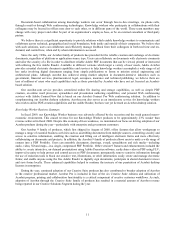Adobe 2009 Annual Report Download - page 21
Download and view the complete annual report
Please find page 21 of the 2009 Adobe annual report below. You can navigate through the pages in the report by either clicking on the pages listed below, or by using the keyword search tool below to find specific information within the annual report.21
Platform Segment
Central to our long-term strategy is our Adobe Flash Platform which enables the development and delivery of
applications, content and video which dramatically improve how businesses engage with their customers and constituents.
The Adobe Flash Platform includes client technologies such as Adobe Flash Player, Adobe Flash Lite and Adobe AIR. It
also includes developer tools and technologies such as Adobe Flash Professional, Adobe Flash Builder (formerly Flex
Builder), Adobe Flash Catalyst, Adobe Flash Platform Services and Adobe Flex. In addition, server technologies such as
Adobe FMS and Adobe LiveCycle Data Services round out our Flash Platform offerings. Of these products and services,
Flash Professional, FMS and LiveCycle Data services are managed and delivered in other Adobe business units, yet they
remain core components of our Flash Platform.
Platform Market Opportunity, Business Summary and Strategy
Our Platform Business Unit focuses on the development, marketing and licensing of our Adobe Flash Platform
technologies. We have achieved penetration of Adobe Flash Player on more than 98% of Web-connected PCs – making it
the most widely distributed rich client software in the world. In addition, Adobe Flash Lite, which is licensed by mobile
handset and consumer electronic device manufacturers, has been distributed on more than 1.2 billion devices as of the Fall of
2009.
The broad reach and rapid adoption of the newest versions of these Adobe Flash Platform technologies allows us to
rapidly innovate with our desktop and enterprise server software which utilize these technologies – enabling our customers to
deliver new and more engaging experiences to their constituents that leverage the latest advancements in operating systems,
hardware and rich media technologies.
Our most recent major release of Adobe Flash Player for personal computers, version 10, was delivered in the fall of
2008. Within ten months of availability, more than 93% of Web-connected PCs in mature markets had this latest version
installed, the fastest adoption ever for a new version of our Flash Player. Building upon the success of Flash Player 10, we
released a beta version of Flash Player 10.1 in November of 2009. In concert with the availability of new versions of our
Flash server products, the newest Flash Player adds improved video capabilities such as HTTP streaming, content protection,
peer-to-peer support, and enhanced digital video recorder capabilities such as pause, instant replay, and slow motion.
Due to the success and frequent electronic downloads of client technologies such as Flash Player, we generate revenue
through OEM relationships with companies such as Google, where we include their technologies as part of the download
offerings of our client technologies. In fiscal 2009, this download revenue grew by more than 40% when compared to fiscal
2008, and represented a significant part of the overall revenue we reported in our Platform segment.
As hundreds of millions of people around the world adopt Internet-connected hand-held phones and devices as a means
to communicate, collaborate and entertain, as well as consumer electronic devices such as digital cameras, game consoles,
music players and electronic educational toys, we believe a significant opportunity exists to offer our Adobe Flash Platform
technologies for these devices to provide for the creation and delivery of rich content, user interfaces and data services which
allow users to engage with information more easily and effectively. This trend equally applies to categories such as
Netbooks and Internet-connected televisions, and the explosion in adoption of such devices is creating a challenge for content
owners and application developers to deliver consistent experiences across multiple devices, operating systems, Web
browsers and screen sizes.
To address this opportunity, we participate in the Open Screen Project (“OSP”), which enables designer and developers
to seamlessly publish content and applications across connected devices that utilize Adobe Flash and AIR as a technology
foundation. Initially started in May 2008 with approximately twenty other participating companies, momentum for OSP grew
significantly in fiscal 2009 as the number of member companies supporting OSP grew to approximately fifty by October of
2009. Newest OSP members include Google, RIM and Palm, who join many other hardware manufacturers, mobile and
television technology providers and media companies.
Essential to the momentum of OSP was our decision to eliminate licensing fees with our Flash client technology, as well
as progress towards our goal of delivering the full Flash Player that currently runs on PCs to the smartphone platform. The
removal of Flash licensing fees due to OSP resulted in an expected decline in Flash Lite mobile client revenue, with revenue
in fiscal 2009 decreasing by more than fifty percent when compared to revenue achieved in fiscal 2008.
To address the opportunity of explosive growth in smartphone adoption, we made significant technological progress
during the year with the conversion of Flash Player to run on non-PC devices. New Flash Player improvements include
improved graphics acceleration, audio/video decoding, battery optimization, improved rendering speed and reduced memory
























